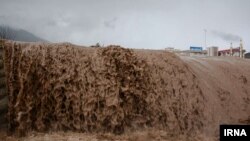A new storm system moved into western Iran on Sunday and many cities are witnessing strong rains, as Iran's Meteorological Organization (IMRO) has warned of strong winds and storms in the next two days.
The official death toll stands at 45 and even in the capital Tehran more than 20 neighborhoods have received text messages warning of strong winds and storms.
IMRO has also warned eleven provinces to expect strong rainstorms and high winds, accompanied by overflowing rivers and floods. In central Iran, Yazd Isfahan, Qom, northern Fars and the Tehran region have been warned about winds with storm intensity.
Khuzestan
In the oil-producing Khuzestan region, the greatest concern is about Karkheh Dam. Authorities decided to open the emergency flood gates on Sunday to prevent water from overflowing the dam. Emergency has already been declared in the province.
Aerial video of Karkheh dam shows water almost reaching the top.
This however means flooding for villages and towns lying on the path of the out-flowing water. Thousands of people have been evacuated in the province and many roads are now buried in water.
Lorestan
In the province of Lorestan, just north of Khuzestan, five more people have been reported lost to floods.
The situation in two towns is alarming. Flood waters have swamped the town of Noorabad, and the city of Dorood with a population of 23,000 is experiencing floods and also facing danger from a nearby dam, which is almost full.
Flooding in Noorabad, Lorestan
Deputy Governor of Lorestan has announced that villages around Dorood face serious danger and at least 25,000 people must be evacuated.
Kermanshah
The new storm front has caused heavy rains in the western province of Kermanshah Sunday afternoon and evening. Jalil Balaee general director of disaster management told Tasnim news agency that an evacuation warning has been issued for 19,000 people living near rivers.
Government agencies and many businesses were closed on Sunday and will keep their doors shut on Monday.
Other Regions
In Isfahan province, officials announced that water has surpassed the 57meter-high Golpaygan dam, which can hold 36.5 million cubic meters of water.
The situation in other areas in western Iran is also critical, with rivers breaking their banks and many roads becoming impassable.
Lack of Coordination and Politicization of the Disaster
After more than a week of flooding, Iranian officials continue to contradict one another and lack of planning becomes evident.
Sunday morning local government-controlled media in Ahvaz reported that several areas of the city must be evacuated. Later the governor of the city denied these reports and insisted there is no threat to the city.
A health official in Khuzestan announced that there is danger of sewage getting mixed up with drinking water. Hours later the general director of the water department said there is no reason to be concerned and “things are under control”.
At a higher level, disagreements between President Hassan Rouhani and the Islamic Revolution Guard Corps (IRGC) are still reverberating. The Guard continued its controversial demolition work using explosives to relieve flood water in Golestan and Khuzestan provinces.
Hossein Shriatmadari, an ultra-hardliner close to Iran’s Supreme Leader Ali Khamenei criticized Rouhani for not being thankful to the IRGC for their efforts in dealing with floods.
Unlike the first days of the floods, senior political and military officials have intensified their visits to various regions, often to show their presence to the people, who are still confused and in panic to deal with the natural disaster.
However, authorities are seen as unprepared, without clear plans and emergency agencies with insufficient budgets to deal with a large scale calamity.










